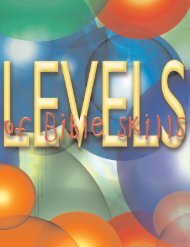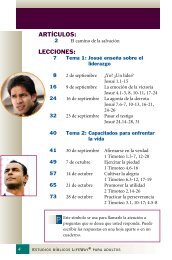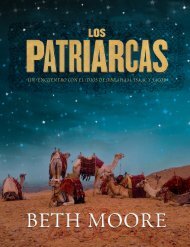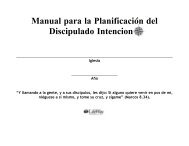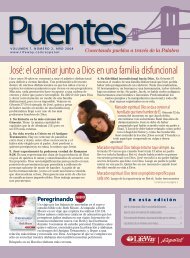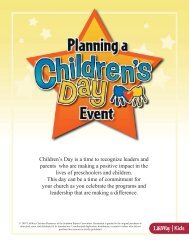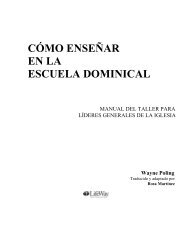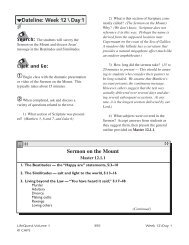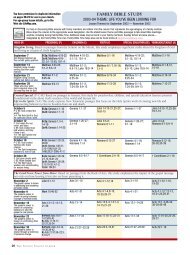Infants and Toddlers ⢠Unit 7: Learning About Good Food - LifeWay
Infants and Toddlers ⢠Unit 7: Learning About Good Food - LifeWay
Infants and Toddlers ⢠Unit 7: Learning About Good Food - LifeWay
Create successful ePaper yourself
Turn your PDF publications into a flip-book with our unique Google optimized e-Paper software.
Parents Day Out<br />
<strong>Infants</strong> <strong>and</strong> <strong>Toddlers</strong> • <strong>Unit</strong> 7: <strong>Learning</strong> <strong>About</strong> <strong>Good</strong> <strong>Food</strong><br />
WEEK 1: Fruits Are <strong>Good</strong><br />
_________________________________________________________________<br />
Guidance Tips<br />
• Safe mobiles made with yarn too short to go around a child’s neck are excellent<br />
visual teaching materials for infants <strong>and</strong> toddlers when they are hung at the<br />
correct distances for each age. Before an infant is able to sit, pull up, or grasp<br />
items, hang mobiles about 10 to 12 inches above the crib.<br />
• After an infant is able to reach <strong>and</strong> grasp items, sit up, <strong>and</strong> pull up, hang<br />
mobiles above a crib out of reach but easily in sight. Mobiles also may be hung<br />
from the ceiling at various places in the room. Hold an infant or toddler up to<br />
these mobiles to look at or touch items.<br />
• After an infant can sit up <strong>and</strong> move around in his crib, items which can be h<strong>and</strong>led<br />
may be hung from short, strong cords from the sides of the crib. Always<br />
hang items in such a way that an infant cannot be caught or hung up in the<br />
cords.<br />
Concepts for Emphasis<br />
• Fruits are good to eat<br />
<strong>and</strong> help me grow<br />
strong.<br />
• Many fruits grow on<br />
trees.<br />
• God made trees <strong>and</strong><br />
fruits.<br />
Bible Verses <strong>and</strong> Phrases<br />
• God cares for you<br />
(1 Peter 5:7).<br />
• Thank You, God<br />
(2 Timothy 1:3).<br />
LEARNING ACTIVITIES<br />
Books<br />
Locate the books I Eat Fruit, I Eat Vegetables, <strong>and</strong> I’m Grown Up. Make a book<br />
using several labels from cans of fruit. Glue the fruit label pictures to pieces of<br />
poster board <strong>and</strong> laminate or cover them with clear contact plastic. Tape the left<br />
edges together to form a book. Also bring several clean, empty cans with the<br />
same fruit labels. (Check the cans for sharp edges before giving to infants <strong>and</strong><br />
toddlers.) Place a few plastic Snap-Lock Beads or blocks inside the cans.<br />
As you talk about the pictures of fruits in the book, toddlers may enjoy finding<br />
cans that match the pictures. Say: “We read in the Bible, ‘Thank You, God.’<br />
Thank You, God, for fruits to eat.”<br />
Music<br />
The words in the song “Thank You, God” can be changed to include anything for<br />
which you want to sing thanks. For example, “Thank You, God, for bananas to<br />
taste, Thank You, God.”<br />
Nature<br />
Place several pieces of fruit in a large plastic bowl. You might include a banana,<br />
orange, apple, <strong>and</strong> lemon. Supervise children as they h<strong>and</strong>le the fruit so they do<br />
not take a bite from a piece of fruit <strong>and</strong> choke. Provide pieces of banana or small<br />
cups of orange juice for tasting if allergies are not a problem. As infants <strong>and</strong> toddlers<br />
h<strong>and</strong>le the fruit, say: “God made the fruit that grows on trees. We read in<br />
the Bible ‘God cares for you.’ God made fruit for Jason to eat.”<br />
Allergy Alert!<br />
Post an allergy alert on the<br />
door notifying parents of<br />
the fruit to be used <strong>and</strong> the<br />
banana or orange juice to<br />
be tasted in the session.<br />
Teaching Pictures<br />
Locate the pictures “Joey Eats an Apple” <strong>and</strong> “Fruit” (pictures 8 <strong>and</strong> 9 from<br />
WEE Learn Teaching Pictures for Two-Year-Olds). Display the bowl of fruit. As<br />
a child holds a piece of fruit, ask him to find the picture of the fruit. Display<br />
magazine or seed-catalog pictures of fruit on a coat hanger mobile.<br />
<strong>Infants</strong> <strong>and</strong> <strong>Toddlers</strong><br />
1
Parents Day Out<br />
<strong>Unit</strong> 7 • <strong>Learning</strong> <strong>About</strong> <strong>Good</strong> <strong>Food</strong><br />
Toys <strong>and</strong> Games<br />
An interesting coordination game for toddlers involves an aluminum tube cake<br />
pan <strong>and</strong> a tennis ball. A toddler will enjoy rotating the pan to make the ball roll<br />
in the track around the center tube.<br />
Additional Ideas for <strong>Toddlers</strong><br />
• Blocks—Place a board, four feet long by ten inches wide, between two cardboard<br />
blocks so toddlers may sit on, walk on, <strong>and</strong> straddle the board. Supervise<br />
as toddlers discover ways to use the board with the blocks.<br />
• Homeliving—Provide several large plastic containers <strong>and</strong> lids. Screwing lids<br />
off <strong>and</strong> on is a good exercise for coordination.<br />
• Puzzles—Display the picture “Friends Playing Together” (picture 46 from WEE<br />
Learn Teaching Pictures for Two-Year-Olds) near the wooden puzzles “Fruit”<br />
<strong>and</strong> “Vegetables.”<br />
Evaluation<br />
• In what ways did infants <strong>and</strong> toddlers have firsth<strong>and</strong> experiences with fruits?<br />
• What Bible truths did children hear?<br />
________________________________________________________________<br />
WEEK 2: Vegetables Are <strong>Good</strong><br />
________________________________________________________________<br />
Guidance Tips<br />
• If it is raining during the session, take one child at a time outside for a few<br />
moments. St<strong>and</strong> under an awning or porch while you watch the rain fall <strong>and</strong><br />
feel drops of rain which may blow on you.<br />
• Sing a song <strong>and</strong> softly talk to the child about the rain God gives to provide<br />
water for people. Say that vegetables need water to grow to make good food<br />
for people.<br />
• The sense of enjoyment <strong>and</strong> awe that you feel during the time outside in the<br />
rain will communicate itself to infants <strong>and</strong> toddlers. Attitudes truly are<br />
“caught,” not taught.<br />
LEARNING ACTIVITIES<br />
Books<br />
Check your supply of books to locate those which have pictures of vegetables<br />
<strong>and</strong> other foods. Also make a vegetable label picture book similar to the fruit<br />
book described in the previous session. Place books in a colorful plastic dishpan<br />
on the floor. Position several large pillows on the floor for children to lie against<br />
or sit on as they look at books. Younger preschoolers enjoy books more when<br />
they can sit close to you in a cozy environment.<br />
Music<br />
Softly strum a zither as you sing songs or talk with infants <strong>and</strong> toddlers. The<br />
novelty <strong>and</strong> interest of this music may distract <strong>and</strong> calm children who are upset.<br />
Sing “God Loves Me,” substituting names of vegetables as you focus on food.<br />
If children go outside to enjoy the rain, sing the song “When It Rains.”<br />
<strong>Infants</strong> <strong>and</strong> <strong>Toddlers</strong><br />
Concepts for Emphasis<br />
• Vegetables are good<br />
to eat <strong>and</strong> help me<br />
grow strong.<br />
• Vegetables need<br />
sunshine <strong>and</strong> rain<br />
to grow.<br />
• God made the<br />
vegetables.<br />
Bible Verses <strong>and</strong> Phrases<br />
• God made us<br />
(Psalm 100:3).<br />
• Work with your h<strong>and</strong>s<br />
(1 Thessalonians 4:11).<br />
2
Parents Day Out<br />
<strong>Unit</strong> 7 • <strong>Learning</strong> <strong>About</strong> <strong>Good</strong> <strong>Food</strong><br />
Nature<br />
Pour a half inch of water in a dishpan <strong>and</strong> place it on plastic sheeting to catch<br />
spills. Place two or three small potatoes <strong>and</strong> carrots nearby. Carefully supervise<br />
as one or two children wash the vegetables. Remind older infants <strong>and</strong> toddlers<br />
that the water needs to stay in the dishpan. As children play in the water <strong>and</strong><br />
wash the vegetables, say: “You are washing the vegetables with your h<strong>and</strong>s. We<br />
read in the Bible ‘Work with your h<strong>and</strong>s.’ Farmers work with their h<strong>and</strong>s to<br />
plant potatoes <strong>and</strong> carrots. Thank You, God, for vegetables we eat.” Remove the<br />
water from the room immediately after this activity.<br />
Teaching Pictures<br />
Locate the pictures “Friends Playing Together” (picture 46 from WEE Learn<br />
Teaching Pictures for Two-Year-Olds). Display this picture along with other pictures<br />
of vegetables (from magazines <strong>and</strong> seed catalogs) around the room. Using<br />
small pictures of vegetables, make a coat hanger (molded plastic) mobile by<br />
tying string to the pictures <strong>and</strong> suspending the pictures from the coat hanger.<br />
Hang the mobile from the ceiling <strong>and</strong> hold infants up to see the mobile.<br />
Toys <strong>and</strong> Games<br />
Collect several sizes of empty cans with vegetable picture labels. Remove any<br />
sharp edges inside the can rims. Younger preschoolers will enjoy nesting <strong>and</strong><br />
stacking these cans. Provide colorful plastic Snap-Lock Beads <strong>and</strong> small blocks<br />
to put inside the cans for a fill-<strong>and</strong>-dump activity. As infants <strong>and</strong> toddlers crawl<br />
or walk to toys, manipulate items, fit objects together, <strong>and</strong> so forth, say: “You are<br />
growing strong because you eat good food. God made vegetables for you to eat<br />
<strong>and</strong> grow strong. Let’s open our Bible <strong>and</strong> read the verse ‘God made us.’ ”<br />
Provide a Read to Me Bible for Kids with a marker at this Bible phrases located<br />
in Psalm 100:3.<br />
Additional Ideas for <strong>Toddlers</strong><br />
• Blocks—Place objects shaped like a circle, rectangle, square, <strong>and</strong> half moon on<br />
the floor near the blocks. Prior to the session use a felt-tipped marker to outline<br />
shapes of the objects on a large piece of poster board. Put the poster board on<br />
the floor. Encourage toddlers to match the objects to the shapes on the poster.<br />
• Puzzles—Provide the wooden puzzle “Vegetables.” Ask toddlers to name the<br />
vegetables pictured in the puzzle. If a toddler has difficulty working the puzzle,<br />
offer suggestions <strong>and</strong> encouragement, but do not work the puzzle for him. You<br />
may want to ask another toddler to help.<br />
Evaluation<br />
• Name the experiences children had with vegetables.<br />
• Did you have an opportunity to enjoy rain with infants <strong>and</strong> toddlers?<br />
<strong>Infants</strong> <strong>and</strong> <strong>Toddlers</strong><br />
3
Parents Day Out<br />
<strong>Unit</strong> 7 • <strong>Learning</strong> <strong>About</strong> <strong>Good</strong> <strong>Food</strong><br />
WEEK 3: Milk Is <strong>Good</strong><br />
_________________________________________________________________<br />
Guidance Tips<br />
• <strong>Food</strong> is an important element in your relationship with preschoolers because<br />
much of your time is spent feeding infants <strong>and</strong> assisting toddlers with snacks<br />
<strong>and</strong> meals. Do not hurry children through feedings <strong>and</strong> mealtimes. Pleasant<br />
conversation <strong>and</strong> a gentle touch are important as you help meet the physical,<br />
social, <strong>and</strong> spiritual needs of preschoolers during mealtimes.<br />
• Hold infants as you feed them their bottles. Sing to them <strong>and</strong> gently rock them<br />
as you feed them. Do not prop bottles for infants because younger infants can<br />
choke when left alone with propped bottles.<br />
• When feeding toddlers, seat them at a low, child-sized table. Encourage the<br />
children who want to feed themselves finger foods without assistance. Remain<br />
positive <strong>and</strong> loving.<br />
Concepts for Emphasis<br />
• Milk is good to drink<br />
<strong>and</strong> helps me grow<br />
strong.<br />
• Milk comes from cows.<br />
• God made milk.<br />
Bible Thoughts<br />
• God made us<br />
(Psalm 100:3).<br />
• Thank You, God<br />
(2 Timothy 1:3).<br />
LEARNING ACTIVITIES<br />
Books<br />
Locate the books Baby Farm Animals <strong>and</strong> On the Farm. Prior to the session find<br />
pictures of a bottle of milk, glass of milk, carton of milk, bowl of ice cream, <strong>and</strong><br />
other milk products. Glue each picture to a piece of poster board <strong>and</strong> seal the<br />
pictures inside a small zip-lock bag. Stitch the zip-lock bags together on the left<br />
edges (with the zip-lock openings on the right edges) to form a book.<br />
As you sit on the floor with a toddler or hold an infant <strong>and</strong> look at books, talk<br />
about the good food God provides. Help children name foods such as fruits, vegetables,<br />
milk, <strong>and</strong> so forth. Say: “In the Bible we read, ‘God made us.’ God<br />
made good food for you to grow strong. Thank You, God, for milk to drink.”<br />
Music<br />
The songs “Thank You, God” <strong>and</strong> “The Animal Song” provide opportunities for<br />
boys <strong>and</strong> girls to express themselves through music.<br />
Nature<br />
Prior to the session find two clear plastic bottles with lids which can be sealed<br />
tightly. Fill one bottle about one-third full of water, <strong>and</strong> fill the other bottle onethird<br />
full of milk. Seal both bottles tightly, taping the lids as an additional<br />
precaution. <strong>Infants</strong> <strong>and</strong> toddlers will enjoy holding the plastic bottles, shaking<br />
<strong>and</strong> sloshing the liquids. Name the liquids in the bottles, helping preschoolers<br />
identify <strong>and</strong> name milk <strong>and</strong> water. Say: “A verse in the Bible is ‘Thank You,<br />
God.’ Thank You, God, for milk to drink.” Following the session discard the<br />
contents of both bottles.<br />
Teaching Pictures<br />
Locate pictures of various farm animals. As you look at pictures of animals with<br />
preschoolers, make the sounds of the animals, particularly the “moo” of the cow.<br />
Encourage older infants <strong>and</strong> toddlers to imitate the animal sounds you make.<br />
Say: “God made the cows. Milk comes from cows. Thank You, God, for good<br />
milk to drink.”<br />
<strong>Infants</strong> <strong>and</strong> <strong>Toddlers</strong><br />
4
Parents Day Out<br />
<strong>Unit</strong> 7 • <strong>Learning</strong> <strong>About</strong> <strong>Good</strong> <strong>Food</strong><br />
Toys <strong>and</strong> Games<br />
As you hold babies to feed them their bottles of milk, place colorful socks on the<br />
bottles for infants to feel <strong>and</strong> examine. <strong>Toddlers</strong> will enjoy a game of dropping<br />
clothespins into an empty gallon-sized plastic milk jug. The nonspring, straight<br />
clothespins are best to use with toddlers. Also cut off the top of the milk jug to<br />
provide a larger opening.<br />
Additional Ideas for <strong>Toddlers</strong><br />
• Blocks—Add several cereal box “blocks” to the block area for this session. To<br />
make these, collect several sizes of cereal boxes. Stuff the insides of the cereal<br />
boxes with crumpled newspapers, packing the boxes tightly. Tape the boxes<br />
shut, then cover all sides of the cereal boxes with clear contact plastic. Place<br />
these cereal “blocks” alongside the blocks. <strong>Toddlers</strong> can stack these blocks,<br />
using them much as they would the cardboard blocks. As toddlers manipulate<br />
the cereal boxes, ask, “Do you use milk on the cereal you eat?”<br />
• Homeliving—Place empty milk cartons in the homeliving area for stacking<strong>and</strong>-nesting<br />
activities.<br />
• Puzzles—Provide the wooden puzzles “Farm Animals,” “Pet Pals,” <strong>and</strong><br />
“Transportation.” Remove the front panel from a cereal box. Cut this in half to<br />
make a puzzle.<br />
Evaluation<br />
• What conversation did preschoolers hear about milk?<br />
• Were firsth<strong>and</strong> experiences with milk planned?<br />
________________________________________________________________<br />
WEEK 4: Thank You, God<br />
________________________________________________________________<br />
Guidance Tips<br />
• Younger preschoolers learn about prayer through the examples of teachers <strong>and</strong><br />
parents. As infants <strong>and</strong> toddlers hear you sing or say thank-you to God for<br />
many things throughout the session, they sense the goodness of God <strong>and</strong> your<br />
love for God.<br />
• The thank-you prayers you sing or voice when teaching younger preschoolers<br />
need to be simple, short, specific, <strong>and</strong> spontaneous. Express your thanks to God<br />
in simple words, using one or two sentences. Name specific things in your<br />
prayer, such as thanks for Janie’s mother, David’s strong legs, milk to drink,<br />
<strong>and</strong> so forth. Always use spontaneous prayers rather than memorized prayers.<br />
• Do not expect infants <strong>and</strong> toddlers to bow their heads, repeat prayers after you,<br />
or even stop an activity when you voice a thank-you prayer.<br />
LEARNING ACTIVITIES<br />
Books<br />
Locate the book All <strong>About</strong> Baby! As you sit on the floor with an infant or toddler,<br />
picture-read the book. Express short conversational thank-you prayers about<br />
the child’s own family <strong>and</strong> experiences. For example, you might say: “This is a<br />
picture of a mother <strong>and</strong> daddy. Thank You, God, for Bryan’s mother <strong>and</strong> daddy.”<br />
<strong>Infants</strong> <strong>and</strong> <strong>Toddlers</strong><br />
Concepts for Emphasis<br />
• God loves me <strong>and</strong> gives<br />
me good things to enjoy.<br />
• I hear my teachers say<br />
thank-you to God.<br />
Bible Verses <strong>and</strong> Phrases<br />
• Jesus said, “Love one<br />
another” (John 15:17).<br />
• Thank You, God<br />
(2 Timothy 1:3).<br />
5
Parents Day Out<br />
<strong>Unit</strong> 7 • <strong>Learning</strong> <strong>About</strong> <strong>Good</strong> <strong>Food</strong><br />
Do not expect younger preschoolers to underst<strong>and</strong> how to express gratitude or<br />
thankfulness. Foundations for thankfulness become attitudes in children because<br />
they observe adults expressing thanks.<br />
Music<br />
During resting <strong>and</strong> sleeping times, play a quiet recording. At other times during<br />
the session when infants <strong>and</strong> toddlers are playing, you may want to play segments<br />
from the cassette tape or CD ‘Specially Special Songs. Provide jingle bells<br />
sealed inside small plastic bottles, a coffee-can drum, or other safe noisemakers<br />
for younger preschoolers to shake, rattle, or pound while they listen to music.<br />
Use your singing voice to interest or calm a child, naming the child in the<br />
song. “I Have a <strong>Good</strong> Friend” <strong>and</strong> “Thank You, God” may be adapted to include<br />
the names of specific children.<br />
Nature<br />
Bring fresh flowers for preschoolers to smell. Tie the stems of the flowers to a<br />
coat hanger to make a mobile. Hang the flower mobile out of reach of the children<br />
but in a location where you can hold children up to the mobile as you touch<br />
<strong>and</strong> smell the flowers. Since many flowers are poisonous if eaten, do not allow<br />
children to h<strong>and</strong>le flowers. As you look at the flowers with a child, say: “God<br />
made the flowers. Thank You, God, for pretty flowers <strong>and</strong> for Maria’s nose to<br />
smell the flowers. A verse in the Bible is ‘Thank You, God.’ ”<br />
Allergy Alert!<br />
Post an allergy alert on the<br />
door notifying parents of<br />
the flowers to be used in<br />
the session.<br />
Teaching Pictures<br />
Locate the pictures “Joey Eats an Apple,” “Fruit,” “A Family Walking,” “My<br />
Family Thanks God,” “I Love My Family,” <strong>and</strong> “Thank You, God, for the<br />
World” (pictures 8, 9, 12, 14, 20, <strong>and</strong> 21 from WEE Learn Teaching Pictures for<br />
Two-Year-Olds). Teaching pictures displayed in the room provide you with<br />
opportunities for conversation with children about things for which you can<br />
thank God: good food, family members, friends, Jesus, the Bible, flowers, trees,<br />
<strong>and</strong> so forth.<br />
Make a “thank-you box” by taping four pictures onto the four sides of a large<br />
cardboard grocery box. As an older infant crawls to the box or as a toddler<br />
climbs in <strong>and</strong> out of the box, talk about the pictures.<br />
Toys <strong>and</strong> Games<br />
Prior to the session purchase five or six colorful plastic bangle bracelets.<br />
Younger preschoolers enjoy h<strong>and</strong>ling, mouthing, <strong>and</strong> carrying these bracelets. A<br />
large plastic bottle with a long slim neck is ideal for stacking the bracelets onto.<br />
Also provide a rock-n-stack toy.<br />
<strong>Infants</strong> <strong>and</strong> <strong>Toddlers</strong><br />
6
Parents Day Out<br />
<strong>Unit</strong> 7 • <strong>Learning</strong> <strong>About</strong> <strong>Good</strong> <strong>Food</strong><br />
Additional Ideas for <strong>Toddlers</strong><br />
• Blocks—Provide large soft plastic farm animals <strong>and</strong> several empty shoe boxes.<br />
As toddlers use these along with cardboard blocks, say: “God made the animals.<br />
Thank You, God, for the animals.”<br />
• Homeliving—Place empty food containers <strong>and</strong> cartons in a large grocery bag.<br />
As toddlers pretend to eat food <strong>and</strong> feed dolls, say, “God loves you.” Read the<br />
Bible verse in the Bible “Jesus said, ‘Love one another.’ ” Say, “Thank you<br />
for helping one another <strong>and</strong> for taking care of the dolls.”<br />
• Puzzles—On a small blanket on the floor place the wooden puzzles “ Farm<br />
Animals,” “Fruit,” <strong>and</strong> “Vegetables.” As toddlers work puzzles, say thank-you<br />
prayers for animals <strong>and</strong> food.<br />
Evaluation<br />
• Did you feel gratitude for blessings in your life as you taught preschoolers<br />
today?<br />
• Name specific things for which preschoolers heard you thank God.<br />
RESOURCES<br />
Bible<br />
• Read to Me Bible for Kids • 155819844X (NIrV)<br />
• Read to Me Bible for Kids • 1558198458 (KJV)<br />
Books<br />
• All <strong>About</strong> Baby! (Dorling Kindersley, 1994)<br />
1564585301<br />
• Baby Farm Animals (Penguin Putnam)<br />
0721495486<br />
• I Eat Fruit (Tofts, Zero to Ten) 1840890002<br />
• I Eat Vegetables (Tofts, Zero to Ten) 1840890010<br />
• I’m Grown Up (Miller, Little Simon) 0689800436<br />
• On the Farm (Brown, Dorling Kindersley)<br />
1564582698<br />
Pictures<br />
• WEE Learn Teaching Pictures for Two-Year-Olds<br />
0767333381<br />
Music<br />
• ‘Specially Special Songs: Music for Early<br />
Childhood<br />
Songbook • 0767334884<br />
Double Cassette • 0767334825<br />
Double CD • 0767334817<br />
Puzzles (Constructive Playthings)<br />
• “Fruit” • CP-903 (4 pieces )<br />
• “Transportation” • DL-4001 (5 pieces)<br />
Puzzles (McGraw-Hill Children’s Publishers)<br />
• “Farm Animals” • J040010 (5 pieces)<br />
• “Pet Pals” • J48086 (4 pieces)<br />
• “Vegetables” • J48089 (4 pieces)<br />
Parents Day Out curriculum is published by <strong>LifeWay</strong> Christian Resources of the Southern Baptist Convention, One <strong>LifeWay</strong> Plaza,<br />
Nashville, Tennessee 37234. © 2002 <strong>LifeWay</strong> Christian Resources of the Southern Baptist Convention. All rights reserved.<br />
<strong>Infants</strong> <strong>and</strong> <strong>Toddlers</strong><br />
7



